Advanced Financial Accounting Report: Chorus Limited Analysis, HA3011
VerifiedAdded on 2022/08/24
|12
|2515
|28
Report
AI Summary
This report provides a comprehensive analysis of advanced financial accounting principles, focusing on the application of AASB accounting standards and IFRS. The report examines the financial statements of Chorus Limited, a telecommunications company, evaluating its reporting entity, and the fundamental qualitative characteristics of relevance and faithful representation. It delves into the company's overview, including its infrastructure and services, and assesses its adherence to accounting standards within the Australian accounting framework. The analysis includes discussions on the concept of reporting entity, the importance of consolidated financial statements, and the application of qualitative characteristics in financial reporting. The report also covers the company's adoption of new accounting standards and provides insights into its financial performance, including revenue, expenses, and key audit matters. The conclusion emphasizes the significance of IFRS in ensuring a transparent view of a company's financial position and the relevance of the annual report for stakeholders. The report also suggests areas for improvement, such as providing more detailed explanations of assets, liabilities, and accounting standards.
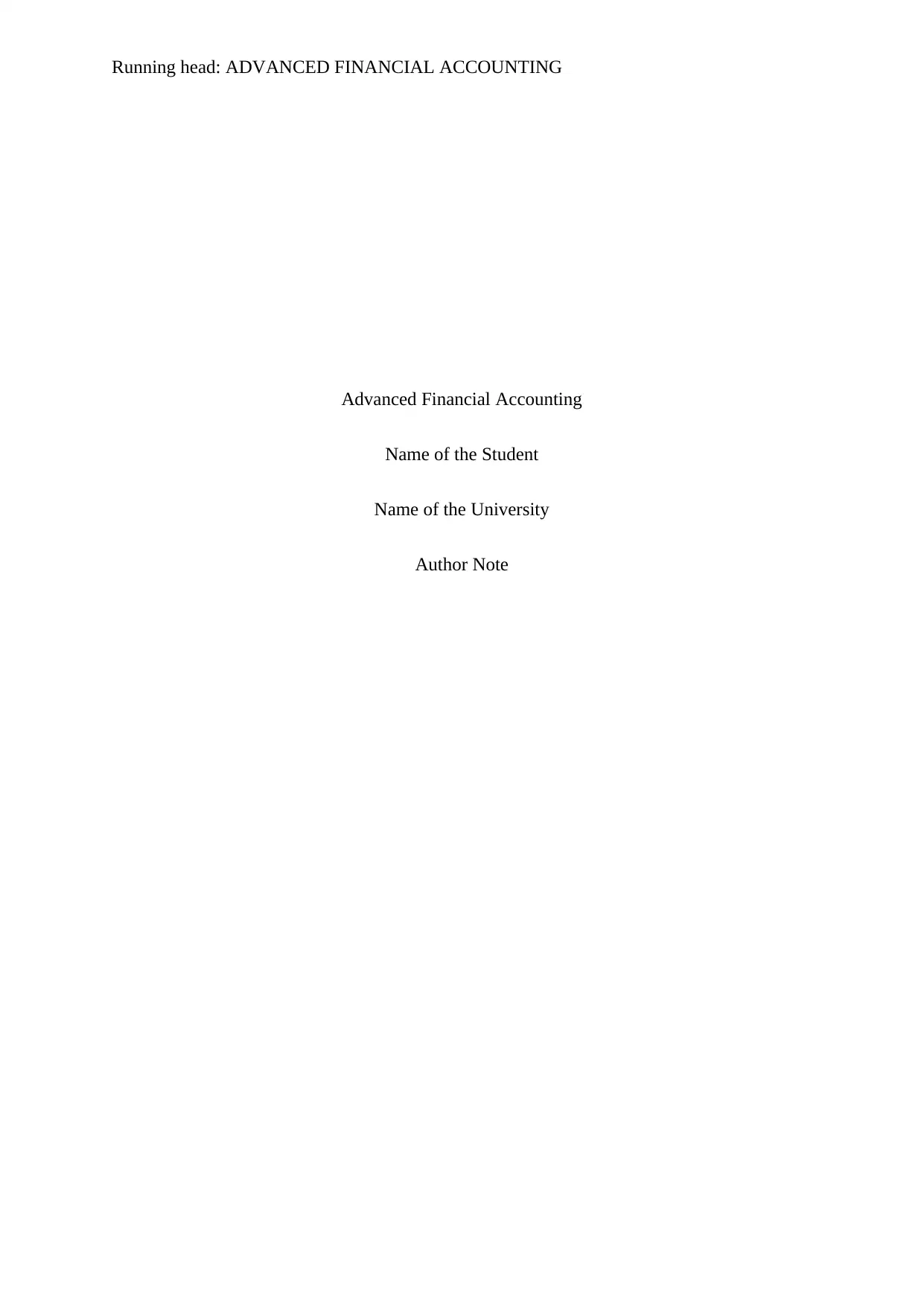
Running head: ADVANCED FINANCIAL ACCOUNTING
Advanced Financial Accounting
Name of the Student
Name of the University
Author Note
Advanced Financial Accounting
Name of the Student
Name of the University
Author Note
Paraphrase This Document
Need a fresh take? Get an instant paraphrase of this document with our AI Paraphraser
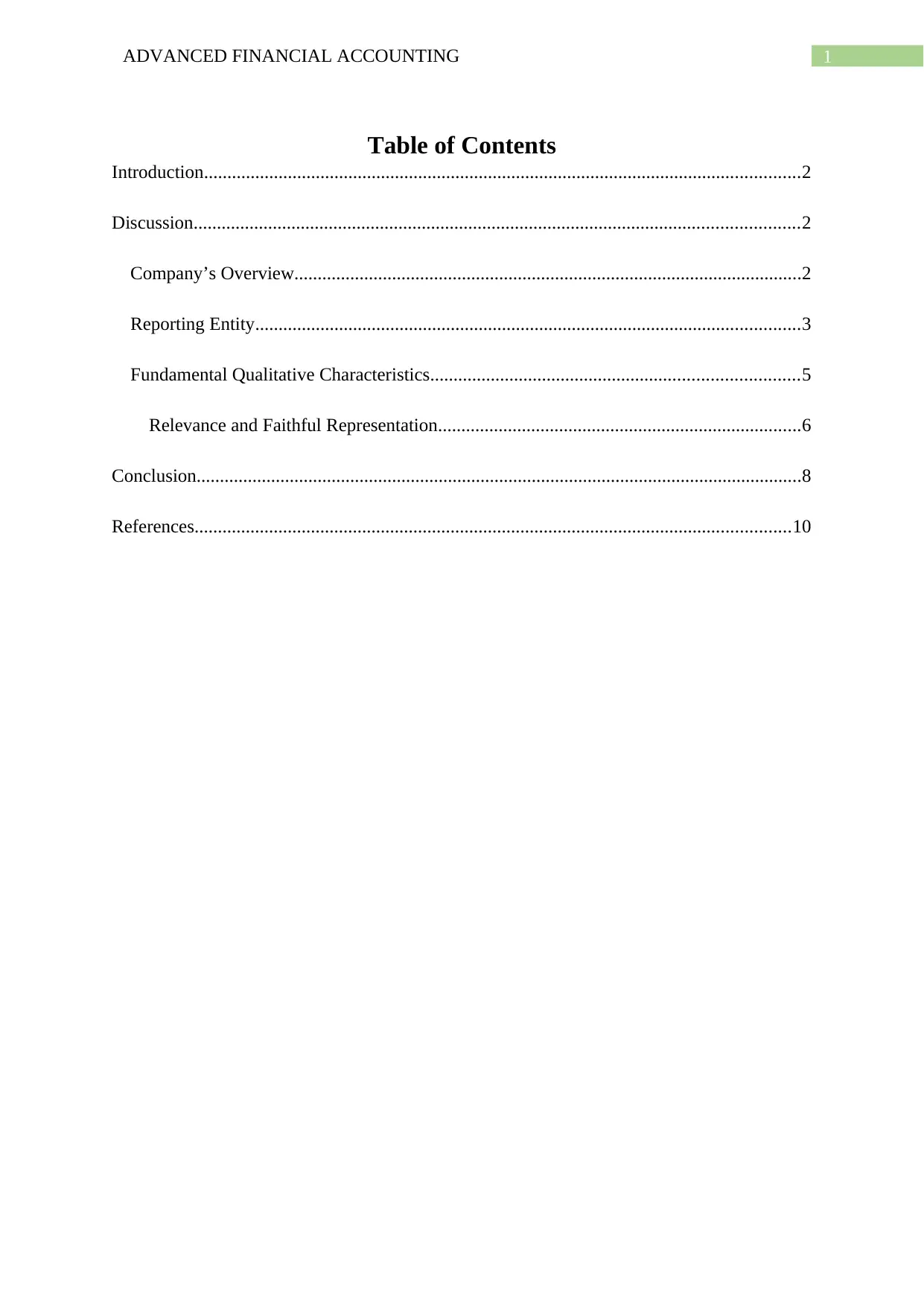
1ADVANCED FINANCIAL ACCOUNTING
Table of Contents
Introduction................................................................................................................................2
Discussion..................................................................................................................................2
Company’s Overview.............................................................................................................2
Reporting Entity.....................................................................................................................3
Fundamental Qualitative Characteristics...............................................................................5
Relevance and Faithful Representation..............................................................................6
Conclusion..................................................................................................................................8
References................................................................................................................................10
Table of Contents
Introduction................................................................................................................................2
Discussion..................................................................................................................................2
Company’s Overview.............................................................................................................2
Reporting Entity.....................................................................................................................3
Fundamental Qualitative Characteristics...............................................................................5
Relevance and Faithful Representation..............................................................................6
Conclusion..................................................................................................................................8
References................................................................................................................................10
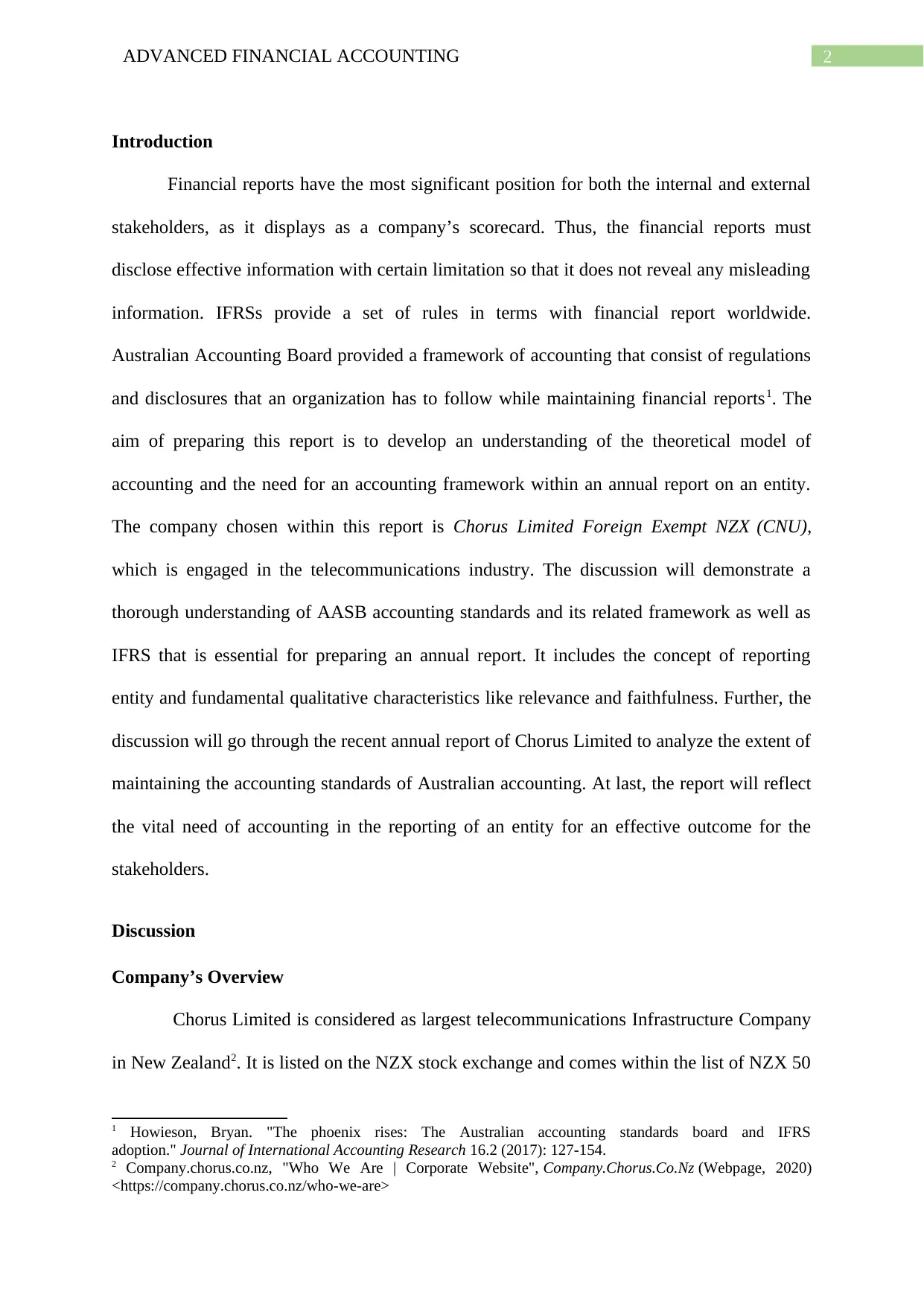
2ADVANCED FINANCIAL ACCOUNTING
Introduction
Financial reports have the most significant position for both the internal and external
stakeholders, as it displays as a company’s scorecard. Thus, the financial reports must
disclose effective information with certain limitation so that it does not reveal any misleading
information. IFRSs provide a set of rules in terms with financial report worldwide.
Australian Accounting Board provided a framework of accounting that consist of regulations
and disclosures that an organization has to follow while maintaining financial reports1. The
aim of preparing this report is to develop an understanding of the theoretical model of
accounting and the need for an accounting framework within an annual report on an entity.
The company chosen within this report is Chorus Limited Foreign Exempt NZX (CNU),
which is engaged in the telecommunications industry. The discussion will demonstrate a
thorough understanding of AASB accounting standards and its related framework as well as
IFRS that is essential for preparing an annual report. It includes the concept of reporting
entity and fundamental qualitative characteristics like relevance and faithfulness. Further, the
discussion will go through the recent annual report of Chorus Limited to analyze the extent of
maintaining the accounting standards of Australian accounting. At last, the report will reflect
the vital need of accounting in the reporting of an entity for an effective outcome for the
stakeholders.
Discussion
Company’s Overview
Chorus Limited is considered as largest telecommunications Infrastructure Company
in New Zealand2. It is listed on the NZX stock exchange and comes within the list of NZX 50
1 Howieson, Bryan. "The phoenix rises: The Australian accounting standards board and IFRS
adoption." Journal of International Accounting Research 16.2 (2017): 127-154.
2 Company.chorus.co.nz, "Who We Are | Corporate Website", Company.Chorus.Co.Nz (Webpage, 2020)
<https://company.chorus.co.nz/who-we-are>
Introduction
Financial reports have the most significant position for both the internal and external
stakeholders, as it displays as a company’s scorecard. Thus, the financial reports must
disclose effective information with certain limitation so that it does not reveal any misleading
information. IFRSs provide a set of rules in terms with financial report worldwide.
Australian Accounting Board provided a framework of accounting that consist of regulations
and disclosures that an organization has to follow while maintaining financial reports1. The
aim of preparing this report is to develop an understanding of the theoretical model of
accounting and the need for an accounting framework within an annual report on an entity.
The company chosen within this report is Chorus Limited Foreign Exempt NZX (CNU),
which is engaged in the telecommunications industry. The discussion will demonstrate a
thorough understanding of AASB accounting standards and its related framework as well as
IFRS that is essential for preparing an annual report. It includes the concept of reporting
entity and fundamental qualitative characteristics like relevance and faithfulness. Further, the
discussion will go through the recent annual report of Chorus Limited to analyze the extent of
maintaining the accounting standards of Australian accounting. At last, the report will reflect
the vital need of accounting in the reporting of an entity for an effective outcome for the
stakeholders.
Discussion
Company’s Overview
Chorus Limited is considered as largest telecommunications Infrastructure Company
in New Zealand2. It is listed on the NZX stock exchange and comes within the list of NZX 50
1 Howieson, Bryan. "The phoenix rises: The Australian accounting standards board and IFRS
adoption." Journal of International Accounting Research 16.2 (2017): 127-154.
2 Company.chorus.co.nz, "Who We Are | Corporate Website", Company.Chorus.Co.Nz (Webpage, 2020)
<https://company.chorus.co.nz/who-we-are>
⊘ This is a preview!⊘
Do you want full access?
Subscribe today to unlock all pages.

Trusted by 1+ million students worldwide
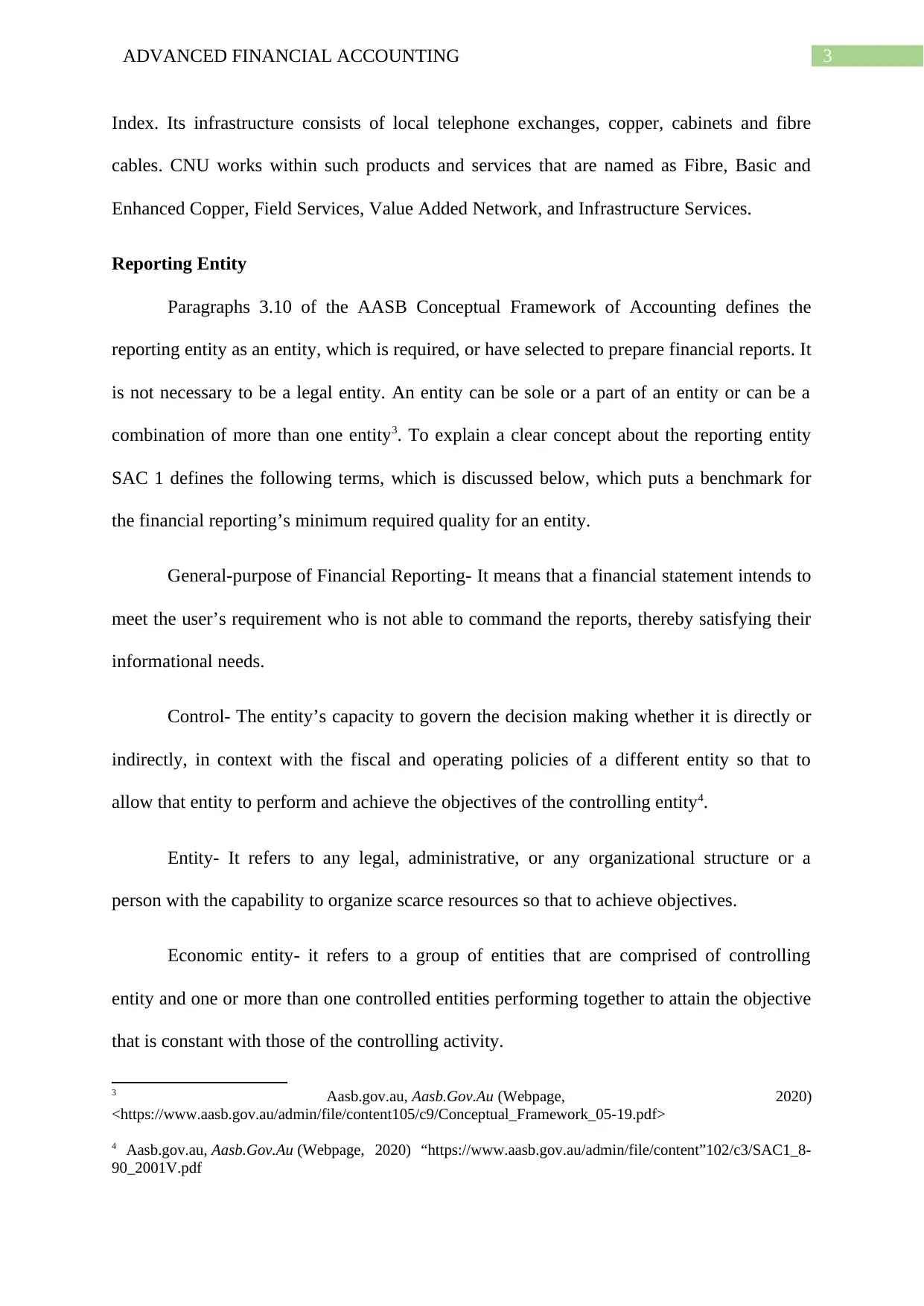
3ADVANCED FINANCIAL ACCOUNTING
Index. Its infrastructure consists of local telephone exchanges, copper, cabinets and fibre
cables. CNU works within such products and services that are named as Fibre, Basic and
Enhanced Copper, Field Services, Value Added Network, and Infrastructure Services.
Reporting Entity
Paragraphs 3.10 of the AASB Conceptual Framework of Accounting defines the
reporting entity as an entity, which is required, or have selected to prepare financial reports. It
is not necessary to be a legal entity. An entity can be sole or a part of an entity or can be a
combination of more than one entity3. To explain a clear concept about the reporting entity
SAC 1 defines the following terms, which is discussed below, which puts a benchmark for
the financial reporting’s minimum required quality for an entity.
General-purpose of Financial Reporting- It means that a financial statement intends to
meet the user’s requirement who is not able to command the reports, thereby satisfying their
informational needs.
Control- The entity’s capacity to govern the decision making whether it is directly or
indirectly, in context with the fiscal and operating policies of a different entity so that to
allow that entity to perform and achieve the objectives of the controlling entity4.
Entity- It refers to any legal, administrative, or any organizational structure or a
person with the capability to organize scarce resources so that to achieve objectives.
Economic entity- it refers to a group of entities that are comprised of controlling
entity and one or more than one controlled entities performing together to attain the objective
that is constant with those of the controlling activity.
3 Aasb.gov.au, Aasb.Gov.Au (Webpage, 2020)
<https://www.aasb.gov.au/admin/file/content105/c9/Conceptual_Framework_05-19.pdf>
4 Aasb.gov.au, Aasb.Gov.Au (Webpage, 2020) “https://www.aasb.gov.au/admin/file/content”102/c3/SAC1_8-
90_2001V.pdf
Index. Its infrastructure consists of local telephone exchanges, copper, cabinets and fibre
cables. CNU works within such products and services that are named as Fibre, Basic and
Enhanced Copper, Field Services, Value Added Network, and Infrastructure Services.
Reporting Entity
Paragraphs 3.10 of the AASB Conceptual Framework of Accounting defines the
reporting entity as an entity, which is required, or have selected to prepare financial reports. It
is not necessary to be a legal entity. An entity can be sole or a part of an entity or can be a
combination of more than one entity3. To explain a clear concept about the reporting entity
SAC 1 defines the following terms, which is discussed below, which puts a benchmark for
the financial reporting’s minimum required quality for an entity.
General-purpose of Financial Reporting- It means that a financial statement intends to
meet the user’s requirement who is not able to command the reports, thereby satisfying their
informational needs.
Control- The entity’s capacity to govern the decision making whether it is directly or
indirectly, in context with the fiscal and operating policies of a different entity so that to
allow that entity to perform and achieve the objectives of the controlling entity4.
Entity- It refers to any legal, administrative, or any organizational structure or a
person with the capability to organize scarce resources so that to achieve objectives.
Economic entity- it refers to a group of entities that are comprised of controlling
entity and one or more than one controlled entities performing together to attain the objective
that is constant with those of the controlling activity.
3 Aasb.gov.au, Aasb.Gov.Au (Webpage, 2020)
<https://www.aasb.gov.au/admin/file/content105/c9/Conceptual_Framework_05-19.pdf>
4 Aasb.gov.au, Aasb.Gov.Au (Webpage, 2020) “https://www.aasb.gov.au/admin/file/content”102/c3/SAC1_8-
90_2001V.pdf
Paraphrase This Document
Need a fresh take? Get an instant paraphrase of this document with our AI Paraphraser
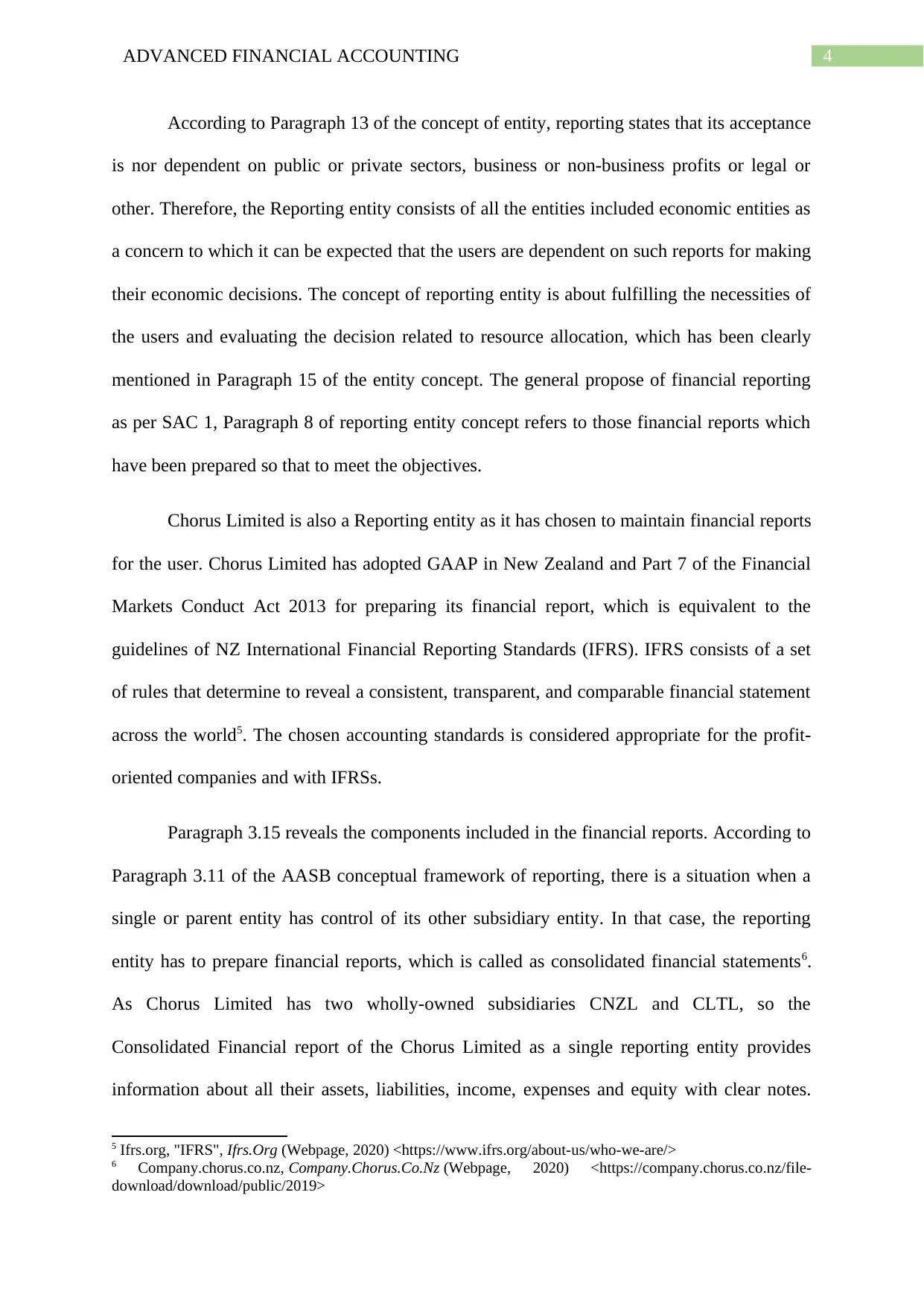
4ADVANCED FINANCIAL ACCOUNTING
According to Paragraph 13 of the concept of entity, reporting states that its acceptance
is nor dependent on public or private sectors, business or non-business profits or legal or
other. Therefore, the Reporting entity consists of all the entities included economic entities as
a concern to which it can be expected that the users are dependent on such reports for making
their economic decisions. The concept of reporting entity is about fulfilling the necessities of
the users and evaluating the decision related to resource allocation, which has been clearly
mentioned in Paragraph 15 of the entity concept. The general propose of financial reporting
as per SAC 1, Paragraph 8 of reporting entity concept refers to those financial reports which
have been prepared so that to meet the objectives.
Chorus Limited is also a Reporting entity as it has chosen to maintain financial reports
for the user. Chorus Limited has adopted GAAP in New Zealand and Part 7 of the Financial
Markets Conduct Act 2013 for preparing its financial report, which is equivalent to the
guidelines of NZ International Financial Reporting Standards (IFRS). IFRS consists of a set
of rules that determine to reveal a consistent, transparent, and comparable financial statement
across the world5. The chosen accounting standards is considered appropriate for the profit-
oriented companies and with IFRSs.
Paragraph 3.15 reveals the components included in the financial reports. According to
Paragraph 3.11 of the AASB conceptual framework of reporting, there is a situation when a
single or parent entity has control of its other subsidiary entity. In that case, the reporting
entity has to prepare financial reports, which is called as consolidated financial statements6.
As Chorus Limited has two wholly-owned subsidiaries CNZL and CLTL, so the
Consolidated Financial report of the Chorus Limited as a single reporting entity provides
information about all their assets, liabilities, income, expenses and equity with clear notes.
5 Ifrs.org, "IFRS", Ifrs.Org (Webpage, 2020) <https://www.ifrs.org/about-us/who-we-are/>
6 Company.chorus.co.nz, Company.Chorus.Co.Nz (Webpage, 2020) <https://company.chorus.co.nz/file-
download/download/public/2019>
According to Paragraph 13 of the concept of entity, reporting states that its acceptance
is nor dependent on public or private sectors, business or non-business profits or legal or
other. Therefore, the Reporting entity consists of all the entities included economic entities as
a concern to which it can be expected that the users are dependent on such reports for making
their economic decisions. The concept of reporting entity is about fulfilling the necessities of
the users and evaluating the decision related to resource allocation, which has been clearly
mentioned in Paragraph 15 of the entity concept. The general propose of financial reporting
as per SAC 1, Paragraph 8 of reporting entity concept refers to those financial reports which
have been prepared so that to meet the objectives.
Chorus Limited is also a Reporting entity as it has chosen to maintain financial reports
for the user. Chorus Limited has adopted GAAP in New Zealand and Part 7 of the Financial
Markets Conduct Act 2013 for preparing its financial report, which is equivalent to the
guidelines of NZ International Financial Reporting Standards (IFRS). IFRS consists of a set
of rules that determine to reveal a consistent, transparent, and comparable financial statement
across the world5. The chosen accounting standards is considered appropriate for the profit-
oriented companies and with IFRSs.
Paragraph 3.15 reveals the components included in the financial reports. According to
Paragraph 3.11 of the AASB conceptual framework of reporting, there is a situation when a
single or parent entity has control of its other subsidiary entity. In that case, the reporting
entity has to prepare financial reports, which is called as consolidated financial statements6.
As Chorus Limited has two wholly-owned subsidiaries CNZL and CLTL, so the
Consolidated Financial report of the Chorus Limited as a single reporting entity provides
information about all their assets, liabilities, income, expenses and equity with clear notes.
5 Ifrs.org, "IFRS", Ifrs.Org (Webpage, 2020) <https://www.ifrs.org/about-us/who-we-are/>
6 Company.chorus.co.nz, Company.Chorus.Co.Nz (Webpage, 2020) <https://company.chorus.co.nz/file-
download/download/public/2019>
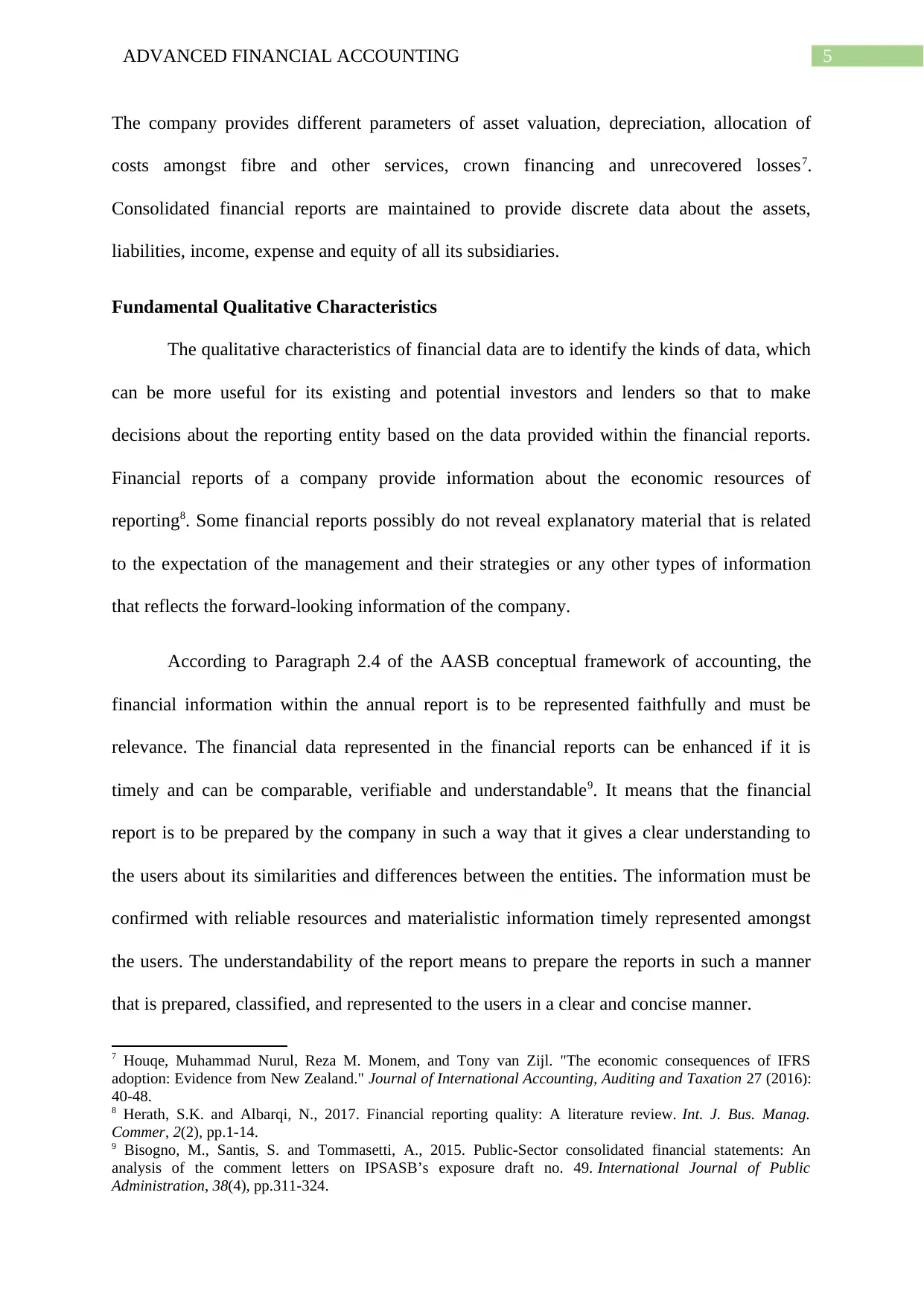
5ADVANCED FINANCIAL ACCOUNTING
The company provides different parameters of asset valuation, depreciation, allocation of
costs amongst fibre and other services, crown financing and unrecovered losses7.
Consolidated financial reports are maintained to provide discrete data about the assets,
liabilities, income, expense and equity of all its subsidiaries.
Fundamental Qualitative Characteristics
The qualitative characteristics of financial data are to identify the kinds of data, which
can be more useful for its existing and potential investors and lenders so that to make
decisions about the reporting entity based on the data provided within the financial reports.
Financial reports of a company provide information about the economic resources of
reporting8. Some financial reports possibly do not reveal explanatory material that is related
to the expectation of the management and their strategies or any other types of information
that reflects the forward-looking information of the company.
According to Paragraph 2.4 of the AASB conceptual framework of accounting, the
financial information within the annual report is to be represented faithfully and must be
relevance. The financial data represented in the financial reports can be enhanced if it is
timely and can be comparable, verifiable and understandable9. It means that the financial
report is to be prepared by the company in such a way that it gives a clear understanding to
the users about its similarities and differences between the entities. The information must be
confirmed with reliable resources and materialistic information timely represented amongst
the users. The understandability of the report means to prepare the reports in such a manner
that is prepared, classified, and represented to the users in a clear and concise manner.
7 Houqe, Muhammad Nurul, Reza M. Monem, and Tony van Zijl. "The economic consequences of IFRS
adoption: Evidence from New Zealand." Journal of International Accounting, Auditing and Taxation 27 (2016):
40-48.
8 Herath, S.K. and Albarqi, N., 2017. Financial reporting quality: A literature review. Int. J. Bus. Manag.
Commer, 2(2), pp.1-14.
9 Bisogno, M., Santis, S. and Tommasetti, A., 2015. Public-Sector consolidated financial statements: An
analysis of the comment letters on IPSASB’s exposure draft no. 49. International Journal of Public
Administration, 38(4), pp.311-324.
The company provides different parameters of asset valuation, depreciation, allocation of
costs amongst fibre and other services, crown financing and unrecovered losses7.
Consolidated financial reports are maintained to provide discrete data about the assets,
liabilities, income, expense and equity of all its subsidiaries.
Fundamental Qualitative Characteristics
The qualitative characteristics of financial data are to identify the kinds of data, which
can be more useful for its existing and potential investors and lenders so that to make
decisions about the reporting entity based on the data provided within the financial reports.
Financial reports of a company provide information about the economic resources of
reporting8. Some financial reports possibly do not reveal explanatory material that is related
to the expectation of the management and their strategies or any other types of information
that reflects the forward-looking information of the company.
According to Paragraph 2.4 of the AASB conceptual framework of accounting, the
financial information within the annual report is to be represented faithfully and must be
relevance. The financial data represented in the financial reports can be enhanced if it is
timely and can be comparable, verifiable and understandable9. It means that the financial
report is to be prepared by the company in such a way that it gives a clear understanding to
the users about its similarities and differences between the entities. The information must be
confirmed with reliable resources and materialistic information timely represented amongst
the users. The understandability of the report means to prepare the reports in such a manner
that is prepared, classified, and represented to the users in a clear and concise manner.
7 Houqe, Muhammad Nurul, Reza M. Monem, and Tony van Zijl. "The economic consequences of IFRS
adoption: Evidence from New Zealand." Journal of International Accounting, Auditing and Taxation 27 (2016):
40-48.
8 Herath, S.K. and Albarqi, N., 2017. Financial reporting quality: A literature review. Int. J. Bus. Manag.
Commer, 2(2), pp.1-14.
9 Bisogno, M., Santis, S. and Tommasetti, A., 2015. Public-Sector consolidated financial statements: An
analysis of the comment letters on IPSASB’s exposure draft no. 49. International Journal of Public
Administration, 38(4), pp.311-324.
⊘ This is a preview!⊘
Do you want full access?
Subscribe today to unlock all pages.

Trusted by 1+ million students worldwide
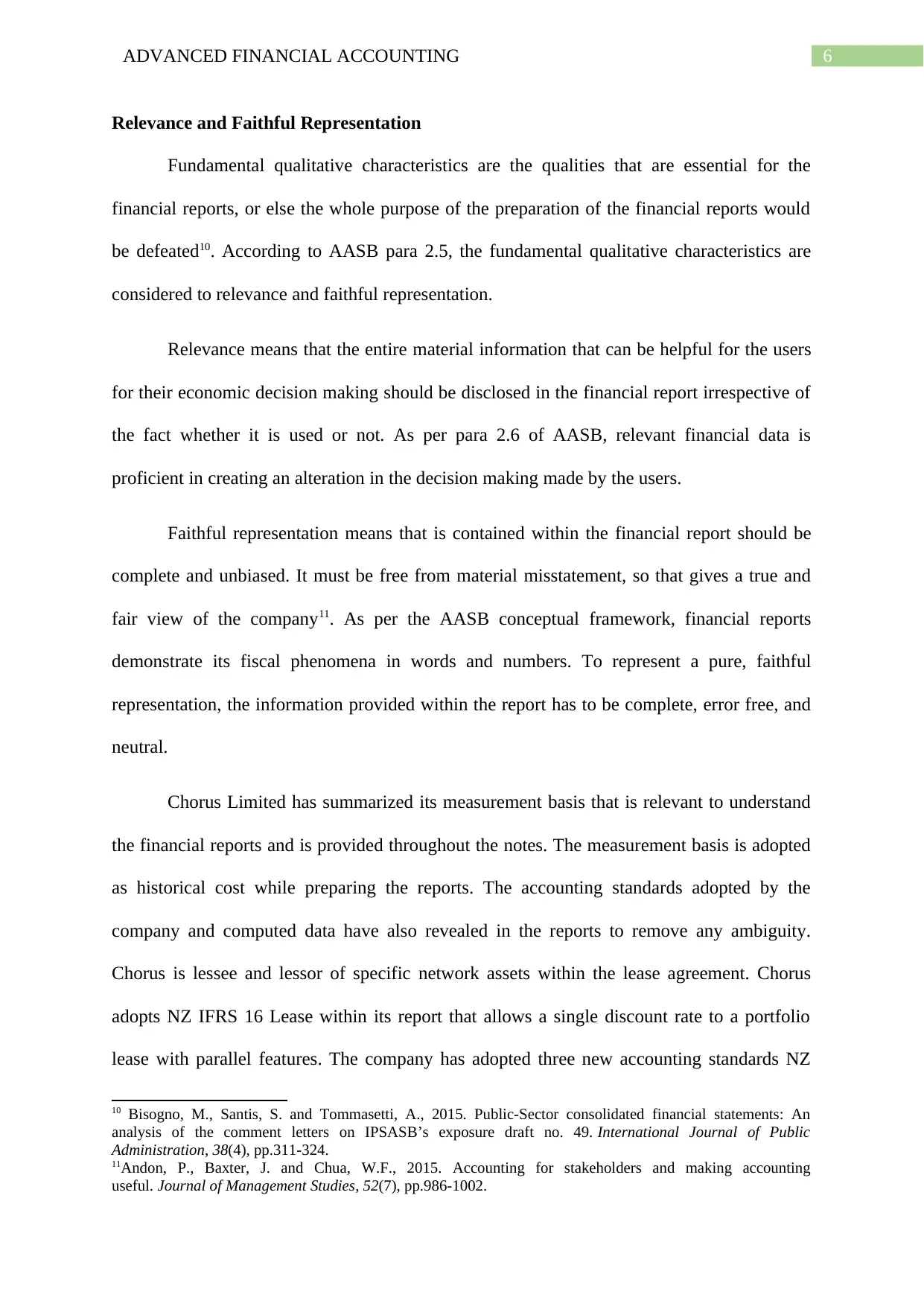
6ADVANCED FINANCIAL ACCOUNTING
Relevance and Faithful Representation
Fundamental qualitative characteristics are the qualities that are essential for the
financial reports, or else the whole purpose of the preparation of the financial reports would
be defeated10. According to AASB para 2.5, the fundamental qualitative characteristics are
considered to relevance and faithful representation.
Relevance means that the entire material information that can be helpful for the users
for their economic decision making should be disclosed in the financial report irrespective of
the fact whether it is used or not. As per para 2.6 of AASB, relevant financial data is
proficient in creating an alteration in the decision making made by the users.
Faithful representation means that is contained within the financial report should be
complete and unbiased. It must be free from material misstatement, so that gives a true and
fair view of the company11. As per the AASB conceptual framework, financial reports
demonstrate its fiscal phenomena in words and numbers. To represent a pure, faithful
representation, the information provided within the report has to be complete, error free, and
neutral.
Chorus Limited has summarized its measurement basis that is relevant to understand
the financial reports and is provided throughout the notes. The measurement basis is adopted
as historical cost while preparing the reports. The accounting standards adopted by the
company and computed data have also revealed in the reports to remove any ambiguity.
Chorus is lessee and lessor of specific network assets within the lease agreement. Chorus
adopts NZ IFRS 16 Lease within its report that allows a single discount rate to a portfolio
lease with parallel features. The company has adopted three new accounting standards NZ
10 Bisogno, M., Santis, S. and Tommasetti, A., 2015. Public-Sector consolidated financial statements: An
analysis of the comment letters on IPSASB’s exposure draft no. 49. International Journal of Public
Administration, 38(4), pp.311-324.
11Andon, P., Baxter, J. and Chua, W.F., 2015. Accounting for stakeholders and making accounting
useful. Journal of Management Studies, 52(7), pp.986-1002.
Relevance and Faithful Representation
Fundamental qualitative characteristics are the qualities that are essential for the
financial reports, or else the whole purpose of the preparation of the financial reports would
be defeated10. According to AASB para 2.5, the fundamental qualitative characteristics are
considered to relevance and faithful representation.
Relevance means that the entire material information that can be helpful for the users
for their economic decision making should be disclosed in the financial report irrespective of
the fact whether it is used or not. As per para 2.6 of AASB, relevant financial data is
proficient in creating an alteration in the decision making made by the users.
Faithful representation means that is contained within the financial report should be
complete and unbiased. It must be free from material misstatement, so that gives a true and
fair view of the company11. As per the AASB conceptual framework, financial reports
demonstrate its fiscal phenomena in words and numbers. To represent a pure, faithful
representation, the information provided within the report has to be complete, error free, and
neutral.
Chorus Limited has summarized its measurement basis that is relevant to understand
the financial reports and is provided throughout the notes. The measurement basis is adopted
as historical cost while preparing the reports. The accounting standards adopted by the
company and computed data have also revealed in the reports to remove any ambiguity.
Chorus is lessee and lessor of specific network assets within the lease agreement. Chorus
adopts NZ IFRS 16 Lease within its report that allows a single discount rate to a portfolio
lease with parallel features. The company has adopted three new accounting standards NZ
10 Bisogno, M., Santis, S. and Tommasetti, A., 2015. Public-Sector consolidated financial statements: An
analysis of the comment letters on IPSASB’s exposure draft no. 49. International Journal of Public
Administration, 38(4), pp.311-324.
11Andon, P., Baxter, J. and Chua, W.F., 2015. Accounting for stakeholders and making accounting
useful. Journal of Management Studies, 52(7), pp.986-1002.
Paraphrase This Document
Need a fresh take? Get an instant paraphrase of this document with our AI Paraphraser
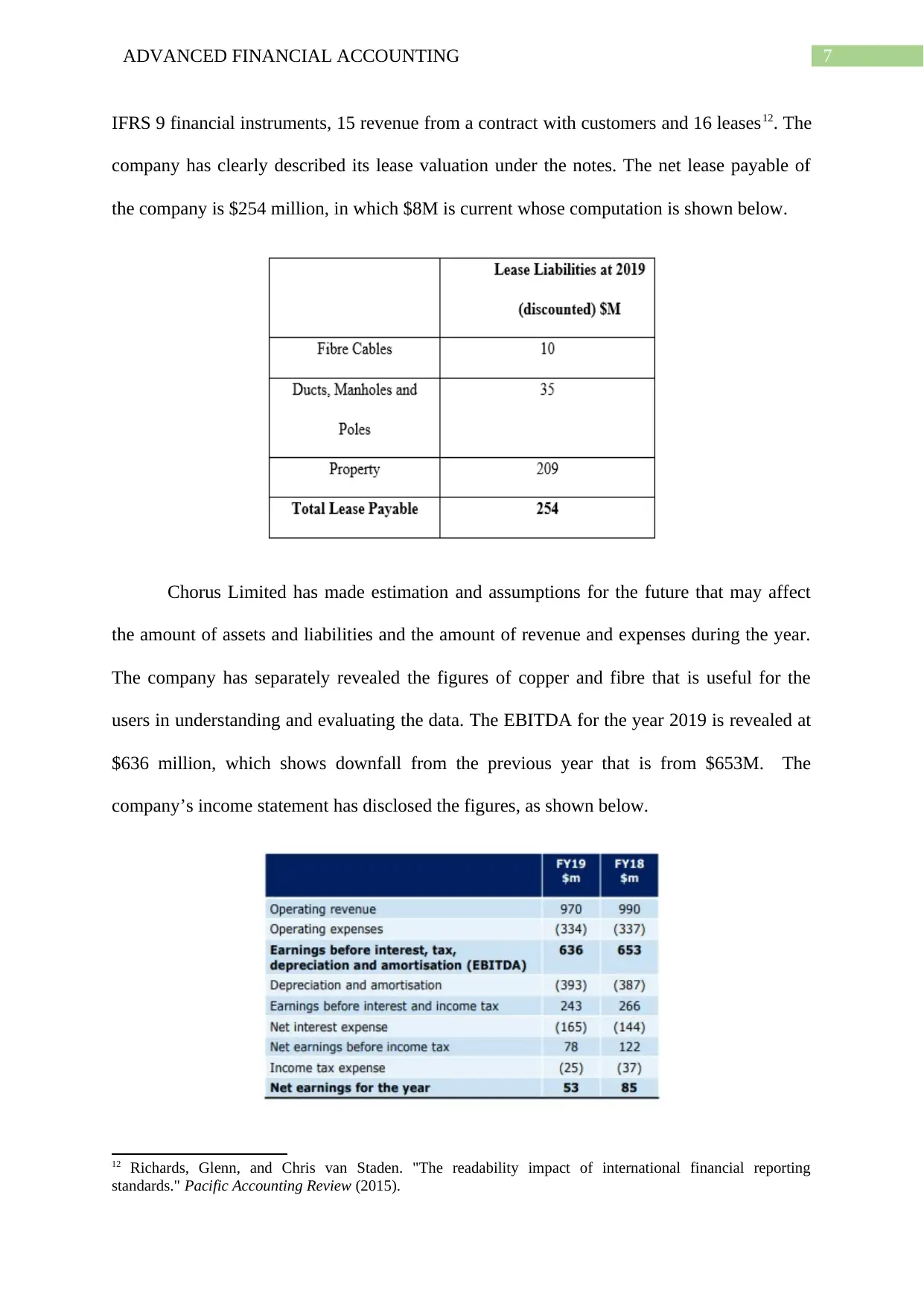
7ADVANCED FINANCIAL ACCOUNTING
IFRS 9 financial instruments, 15 revenue from a contract with customers and 16 leases12. The
company has clearly described its lease valuation under the notes. The net lease payable of
the company is $254 million, in which $8M is current whose computation is shown below.
Chorus Limited has made estimation and assumptions for the future that may affect
the amount of assets and liabilities and the amount of revenue and expenses during the year.
The company has separately revealed the figures of copper and fibre that is useful for the
users in understanding and evaluating the data. The EBITDA for the year 2019 is revealed at
$636 million, which shows downfall from the previous year that is from $653M. The
company’s income statement has disclosed the figures, as shown below.
12 Richards, Glenn, and Chris van Staden. "The readability impact of international financial reporting
standards." Pacific Accounting Review (2015).
IFRS 9 financial instruments, 15 revenue from a contract with customers and 16 leases12. The
company has clearly described its lease valuation under the notes. The net lease payable of
the company is $254 million, in which $8M is current whose computation is shown below.
Chorus Limited has made estimation and assumptions for the future that may affect
the amount of assets and liabilities and the amount of revenue and expenses during the year.
The company has separately revealed the figures of copper and fibre that is useful for the
users in understanding and evaluating the data. The EBITDA for the year 2019 is revealed at
$636 million, which shows downfall from the previous year that is from $653M. The
company’s income statement has disclosed the figures, as shown below.
12 Richards, Glenn, and Chris van Staden. "The readability impact of international financial reporting
standards." Pacific Accounting Review (2015).
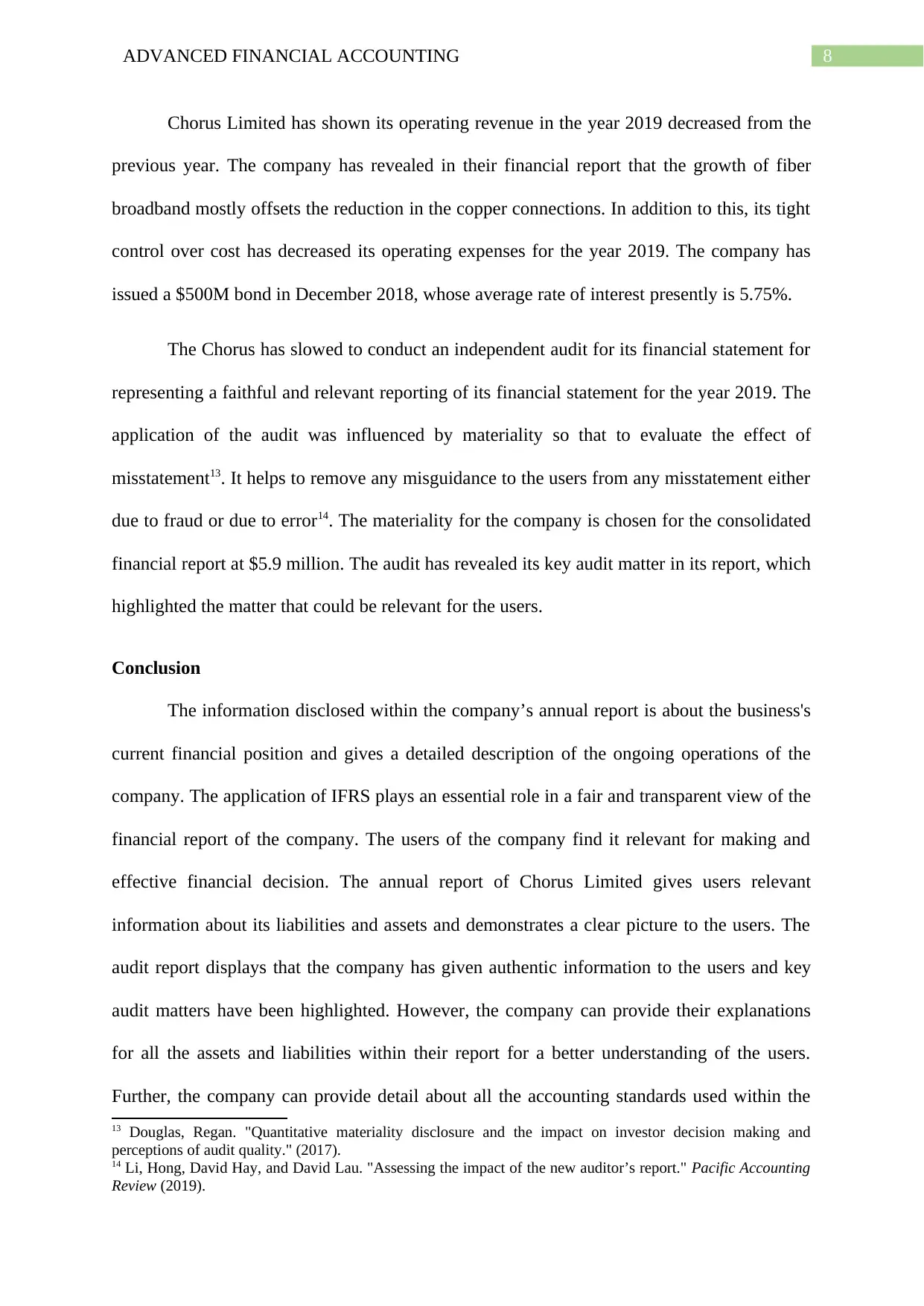
8ADVANCED FINANCIAL ACCOUNTING
Chorus Limited has shown its operating revenue in the year 2019 decreased from the
previous year. The company has revealed in their financial report that the growth of fiber
broadband mostly offsets the reduction in the copper connections. In addition to this, its tight
control over cost has decreased its operating expenses for the year 2019. The company has
issued a $500M bond in December 2018, whose average rate of interest presently is 5.75%.
The Chorus has slowed to conduct an independent audit for its financial statement for
representing a faithful and relevant reporting of its financial statement for the year 2019. The
application of the audit was influenced by materiality so that to evaluate the effect of
misstatement13. It helps to remove any misguidance to the users from any misstatement either
due to fraud or due to error14. The materiality for the company is chosen for the consolidated
financial report at $5.9 million. The audit has revealed its key audit matter in its report, which
highlighted the matter that could be relevant for the users.
Conclusion
The information disclosed within the company’s annual report is about the business's
current financial position and gives a detailed description of the ongoing operations of the
company. The application of IFRS plays an essential role in a fair and transparent view of the
financial report of the company. The users of the company find it relevant for making and
effective financial decision. The annual report of Chorus Limited gives users relevant
information about its liabilities and assets and demonstrates a clear picture to the users. The
audit report displays that the company has given authentic information to the users and key
audit matters have been highlighted. However, the company can provide their explanations
for all the assets and liabilities within their report for a better understanding of the users.
Further, the company can provide detail about all the accounting standards used within the
13 Douglas, Regan. "Quantitative materiality disclosure and the impact on investor decision making and
perceptions of audit quality." (2017).
14 Li, Hong, David Hay, and David Lau. "Assessing the impact of the new auditor’s report." Pacific Accounting
Review (2019).
Chorus Limited has shown its operating revenue in the year 2019 decreased from the
previous year. The company has revealed in their financial report that the growth of fiber
broadband mostly offsets the reduction in the copper connections. In addition to this, its tight
control over cost has decreased its operating expenses for the year 2019. The company has
issued a $500M bond in December 2018, whose average rate of interest presently is 5.75%.
The Chorus has slowed to conduct an independent audit for its financial statement for
representing a faithful and relevant reporting of its financial statement for the year 2019. The
application of the audit was influenced by materiality so that to evaluate the effect of
misstatement13. It helps to remove any misguidance to the users from any misstatement either
due to fraud or due to error14. The materiality for the company is chosen for the consolidated
financial report at $5.9 million. The audit has revealed its key audit matter in its report, which
highlighted the matter that could be relevant for the users.
Conclusion
The information disclosed within the company’s annual report is about the business's
current financial position and gives a detailed description of the ongoing operations of the
company. The application of IFRS plays an essential role in a fair and transparent view of the
financial report of the company. The users of the company find it relevant for making and
effective financial decision. The annual report of Chorus Limited gives users relevant
information about its liabilities and assets and demonstrates a clear picture to the users. The
audit report displays that the company has given authentic information to the users and key
audit matters have been highlighted. However, the company can provide their explanations
for all the assets and liabilities within their report for a better understanding of the users.
Further, the company can provide detail about all the accounting standards used within the
13 Douglas, Regan. "Quantitative materiality disclosure and the impact on investor decision making and
perceptions of audit quality." (2017).
14 Li, Hong, David Hay, and David Lau. "Assessing the impact of the new auditor’s report." Pacific Accounting
Review (2019).
⊘ This is a preview!⊘
Do you want full access?
Subscribe today to unlock all pages.

Trusted by 1+ million students worldwide
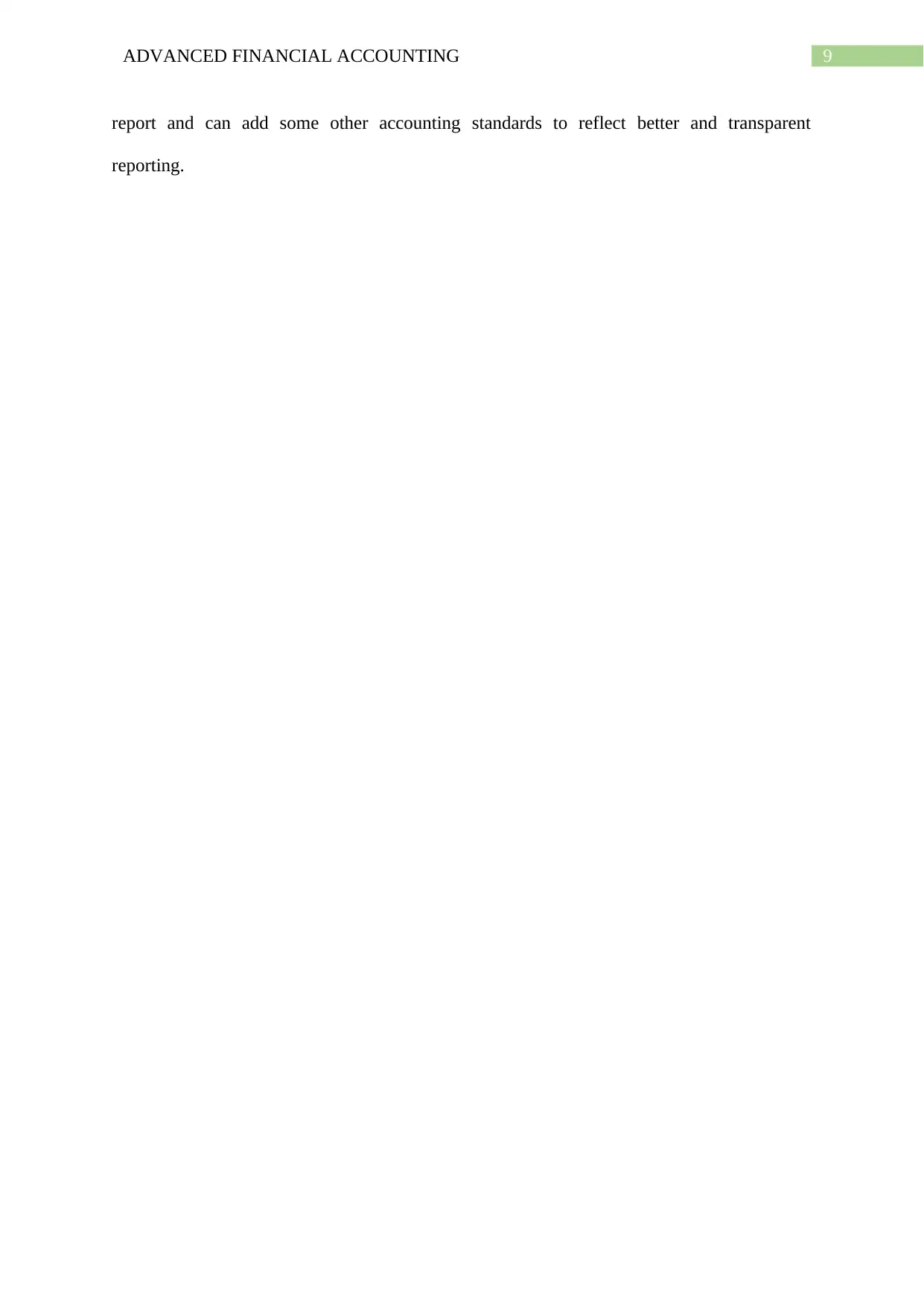
9ADVANCED FINANCIAL ACCOUNTING
report and can add some other accounting standards to reflect better and transparent
reporting.
report and can add some other accounting standards to reflect better and transparent
reporting.
Paraphrase This Document
Need a fresh take? Get an instant paraphrase of this document with our AI Paraphraser
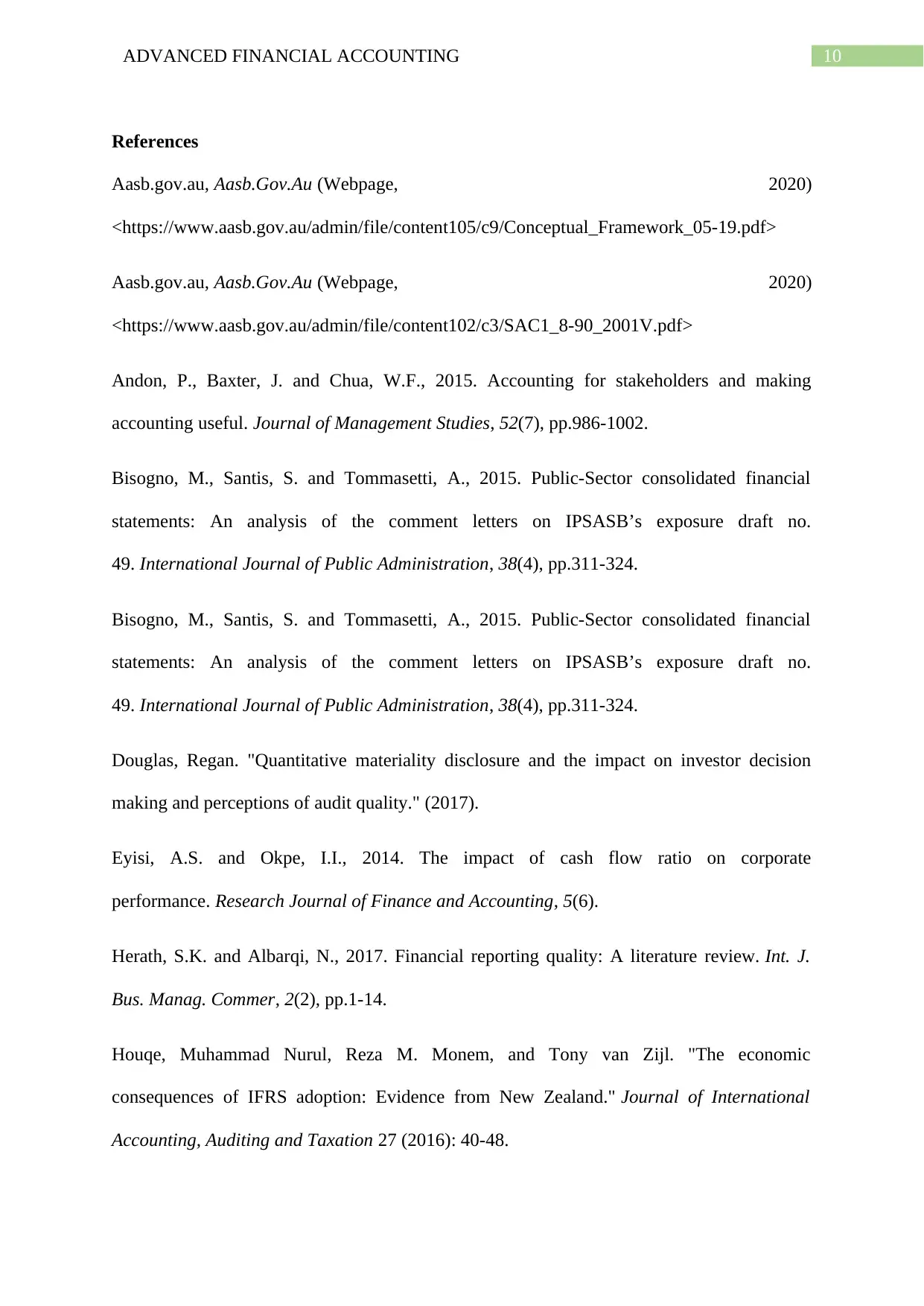
10ADVANCED FINANCIAL ACCOUNTING
References
Aasb.gov.au, Aasb.Gov.Au (Webpage, 2020)
<https://www.aasb.gov.au/admin/file/content105/c9/Conceptual_Framework_05-19.pdf>
Aasb.gov.au, Aasb.Gov.Au (Webpage, 2020)
<https://www.aasb.gov.au/admin/file/content102/c3/SAC1_8-90_2001V.pdf>
Andon, P., Baxter, J. and Chua, W.F., 2015. Accounting for stakeholders and making
accounting useful. Journal of Management Studies, 52(7), pp.986-1002.
Bisogno, M., Santis, S. and Tommasetti, A., 2015. Public-Sector consolidated financial
statements: An analysis of the comment letters on IPSASB’s exposure draft no.
49. International Journal of Public Administration, 38(4), pp.311-324.
Bisogno, M., Santis, S. and Tommasetti, A., 2015. Public-Sector consolidated financial
statements: An analysis of the comment letters on IPSASB’s exposure draft no.
49. International Journal of Public Administration, 38(4), pp.311-324.
Douglas, Regan. "Quantitative materiality disclosure and the impact on investor decision
making and perceptions of audit quality." (2017).
Eyisi, A.S. and Okpe, I.I., 2014. The impact of cash flow ratio on corporate
performance. Research Journal of Finance and Accounting, 5(6).
Herath, S.K. and Albarqi, N., 2017. Financial reporting quality: A literature review. Int. J.
Bus. Manag. Commer, 2(2), pp.1-14.
Houqe, Muhammad Nurul, Reza M. Monem, and Tony van Zijl. "The economic
consequences of IFRS adoption: Evidence from New Zealand." Journal of International
Accounting, Auditing and Taxation 27 (2016): 40-48.
References
Aasb.gov.au, Aasb.Gov.Au (Webpage, 2020)
<https://www.aasb.gov.au/admin/file/content105/c9/Conceptual_Framework_05-19.pdf>
Aasb.gov.au, Aasb.Gov.Au (Webpage, 2020)
<https://www.aasb.gov.au/admin/file/content102/c3/SAC1_8-90_2001V.pdf>
Andon, P., Baxter, J. and Chua, W.F., 2015. Accounting for stakeholders and making
accounting useful. Journal of Management Studies, 52(7), pp.986-1002.
Bisogno, M., Santis, S. and Tommasetti, A., 2015. Public-Sector consolidated financial
statements: An analysis of the comment letters on IPSASB’s exposure draft no.
49. International Journal of Public Administration, 38(4), pp.311-324.
Bisogno, M., Santis, S. and Tommasetti, A., 2015. Public-Sector consolidated financial
statements: An analysis of the comment letters on IPSASB’s exposure draft no.
49. International Journal of Public Administration, 38(4), pp.311-324.
Douglas, Regan. "Quantitative materiality disclosure and the impact on investor decision
making and perceptions of audit quality." (2017).
Eyisi, A.S. and Okpe, I.I., 2014. The impact of cash flow ratio on corporate
performance. Research Journal of Finance and Accounting, 5(6).
Herath, S.K. and Albarqi, N., 2017. Financial reporting quality: A literature review. Int. J.
Bus. Manag. Commer, 2(2), pp.1-14.
Houqe, Muhammad Nurul, Reza M. Monem, and Tony van Zijl. "The economic
consequences of IFRS adoption: Evidence from New Zealand." Journal of International
Accounting, Auditing and Taxation 27 (2016): 40-48.
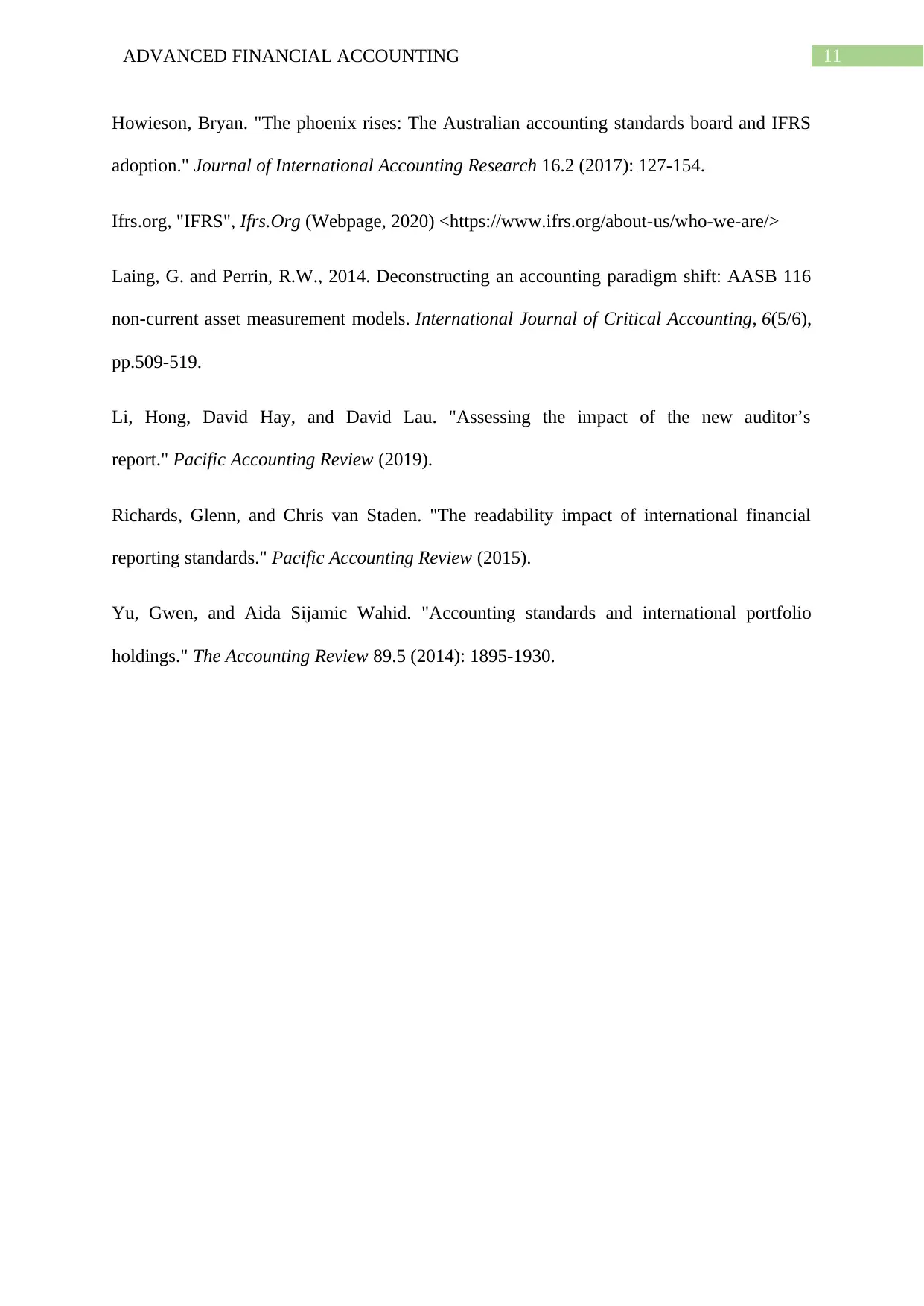
11ADVANCED FINANCIAL ACCOUNTING
Howieson, Bryan. "The phoenix rises: The Australian accounting standards board and IFRS
adoption." Journal of International Accounting Research 16.2 (2017): 127-154.
Ifrs.org, "IFRS", Ifrs.Org (Webpage, 2020) <https://www.ifrs.org/about-us/who-we-are/>
Laing, G. and Perrin, R.W., 2014. Deconstructing an accounting paradigm shift: AASB 116
non-current asset measurement models. International Journal of Critical Accounting, 6(5/6),
pp.509-519.
Li, Hong, David Hay, and David Lau. "Assessing the impact of the new auditor’s
report." Pacific Accounting Review (2019).
Richards, Glenn, and Chris van Staden. "The readability impact of international financial
reporting standards." Pacific Accounting Review (2015).
Yu, Gwen, and Aida Sijamic Wahid. "Accounting standards and international portfolio
holdings." The Accounting Review 89.5 (2014): 1895-1930.
Howieson, Bryan. "The phoenix rises: The Australian accounting standards board and IFRS
adoption." Journal of International Accounting Research 16.2 (2017): 127-154.
Ifrs.org, "IFRS", Ifrs.Org (Webpage, 2020) <https://www.ifrs.org/about-us/who-we-are/>
Laing, G. and Perrin, R.W., 2014. Deconstructing an accounting paradigm shift: AASB 116
non-current asset measurement models. International Journal of Critical Accounting, 6(5/6),
pp.509-519.
Li, Hong, David Hay, and David Lau. "Assessing the impact of the new auditor’s
report." Pacific Accounting Review (2019).
Richards, Glenn, and Chris van Staden. "The readability impact of international financial
reporting standards." Pacific Accounting Review (2015).
Yu, Gwen, and Aida Sijamic Wahid. "Accounting standards and international portfolio
holdings." The Accounting Review 89.5 (2014): 1895-1930.
⊘ This is a preview!⊘
Do you want full access?
Subscribe today to unlock all pages.

Trusted by 1+ million students worldwide
1 out of 12
Related Documents
Your All-in-One AI-Powered Toolkit for Academic Success.
+13062052269
info@desklib.com
Available 24*7 on WhatsApp / Email
![[object Object]](/_next/static/media/star-bottom.7253800d.svg)
Unlock your academic potential
Copyright © 2020–2025 A2Z Services. All Rights Reserved. Developed and managed by ZUCOL.





